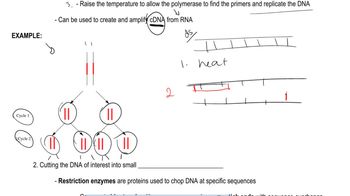Here are the essential concepts you must grasp in order to answer the question correctly.
Polymerase Chain Reaction (PCR)
PCR is a technique used to amplify specific DNA sequences, generating millions of copies from a small initial sample. This amplification is crucial for dideoxy DNA sequencing, as it ensures that there is enough DNA available for analysis. The process involves repeated cycles of denaturation, annealing, and extension, allowing for precise replication of the target DNA.
Recommended video:
Dideoxy Sequencing Method
Dideoxy sequencing, also known as Sanger sequencing, is a method for determining the nucleotide sequence of DNA. It involves incorporating dideoxynucleotides, which terminate DNA strand elongation, into the growing DNA strands during replication. The resulting fragments are then separated by size using gel electrophoresis, allowing for the identification of the sequence based on the labeled ends of the fragments.
Recommended video:
Gel Electrophoresis
Gel electrophoresis is a laboratory technique used to separate DNA fragments based on their size. In the context of dideoxy sequencing, the amplified DNA fragments produced from the sequencing reactions are loaded into a gel matrix and subjected to an electric field. Smaller fragments migrate faster than larger ones, allowing for the visualization of the different lengths of DNA strands, which correspond to the nucleotide sequence.
Recommended video:






